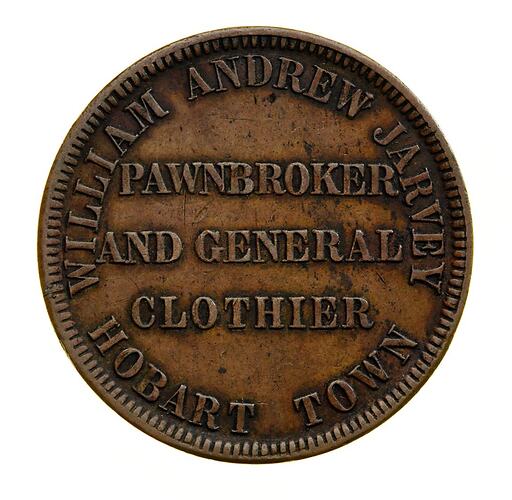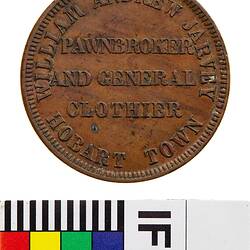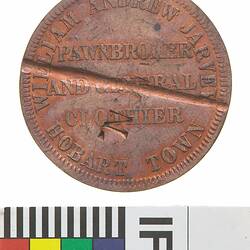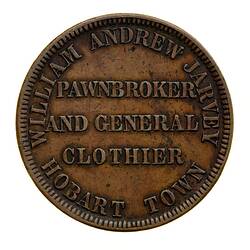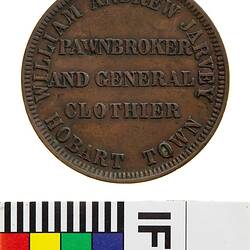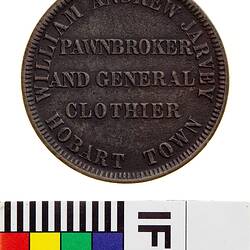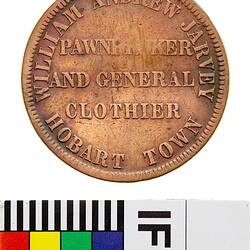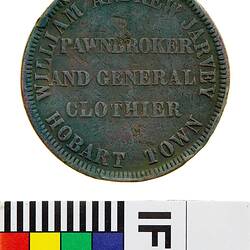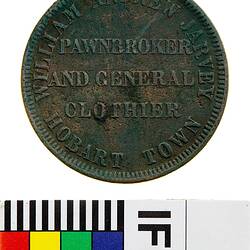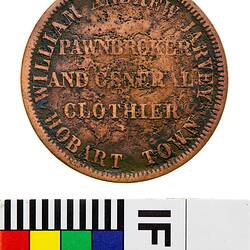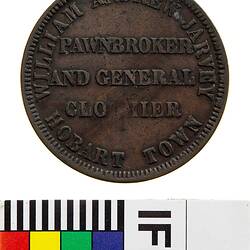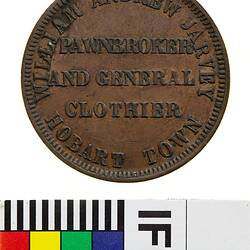William Andrew Jarvey arrived in Tasmania on 8 April 1844. He was 'immediately' appointed a Police Constable, but nine days later he was transferred to the Water Police. In 1849 he obtained permission to marry Catherine Jane Shaw, a 25 year-old Irish convict. The following year he resigned his commission and became the Schoolmaster at the Cascades, outside Hobart.
Jarvey was a relatively well to do man, receiving an allowance of £36 a year from his parents as well as his teacher's salary of £48. In 1854 he left the school and established himself as a Clothier and Pawnbroker in Murray Street, Hobart. He kept this business until 1862, when, according to Graeme Petterwood, the general prosperity of the time made pawnbroking a less attractive business and he was in financial difficulties. Jarvey got out before he became insolvent and attempted farming at Wattle Grove in the Huon Valley, south of Hobart. He gained possession of (either 4 acres or 234 acres of land depending on which of the two sources you believe) in 1862 but he gave up his efforts by November of that year.
He is thought to have issued his tokens in around 1860 (source: Museum Victoria Catalogue).
Gold had been discovered in New Zealand in the previous year. Jarvey convinced the owners of the steamer Titania that he was a suitable Captain for their ship, supplying mining communities in New Zealand. He left his family and sailed to New Zealand in late 1862. The Titania's route often took it between Dunedin and Invercargill.
In April 1864, Catherine Jarvey sold the farm in Wattle Grove and, with their five children, followed him to New Zealand. In August Jarvey beat his wife until she was unconscious. The following month he purchased some rat poison from a chemist, on the pretence that he had rats on board the Titania. On 22 September he returned to the chemist, asking for a stronger mixture as the rats had not been killed, just made ill. According to the published versions of the trial, Catherine Jarvey was taken ill with 'fits' within a few days of the first purchase. On the evening of 26 September, Jarvey administered a fatal dose of strychnine. The doctor who issued the death certificate found that she died of an epileptic fit.
Some three months after the death his eldest daughter, Elizabeth, came forward saying she had seen her father administer the poison to her mother, and that before she died her mother told her what had happened. Jarvey was tried twice for his wife's murder. After the first trial, the jury was undecided after 40 hours of deliberation, with Jarvey's record as a police officer and lack of previous convictions standing him in good stead. The judge dismissed that jury. After his second trial the jury took four hours to find Jarvey guilty and the Judge sentenced him to death. In a statement to the court, Jarvey protested his innocence and railed against his daughter and the jury, saying 'That unfortunate girl in that box has sworn my life away. But I forgive her and may God forgive her.May God forgive all those who had a hand in my destruction.' The Judge, Mr. Richmond replied, saying 'I entirely concur in the verdict which dooms you to the scaffold. You are wrong in treating that verdict as if it stood wholly or in any great part on the testimony of the girl, Elizabeth Anne Jarvey. Her testimony is confirmed by the indubitable testimony of the facts. You have been rightly convicted of murder and you are now adding to that the crime of hipocracy.' (Petterwood)
Jarvey was hanged on 25 October 1865, the first man to be hanged in Dunedin.
References:
Petterwood, G. (1994). 'Born to Hang', in Australian Coin Review, March, pp.26-30.
McNeice, R., Coins and Tokens of Tasmania, 1803-1910, pp.81-83.
Gilkison, R., Early Days in Dunedin - Chapter V: The Jarvey Tragedy, pp.40-53.
More Information
-
Keywords
Trade Tokens, draperies (shops), pawnshops, domestic violence, criminals
-
Localities
-
Authors
-
Article types
